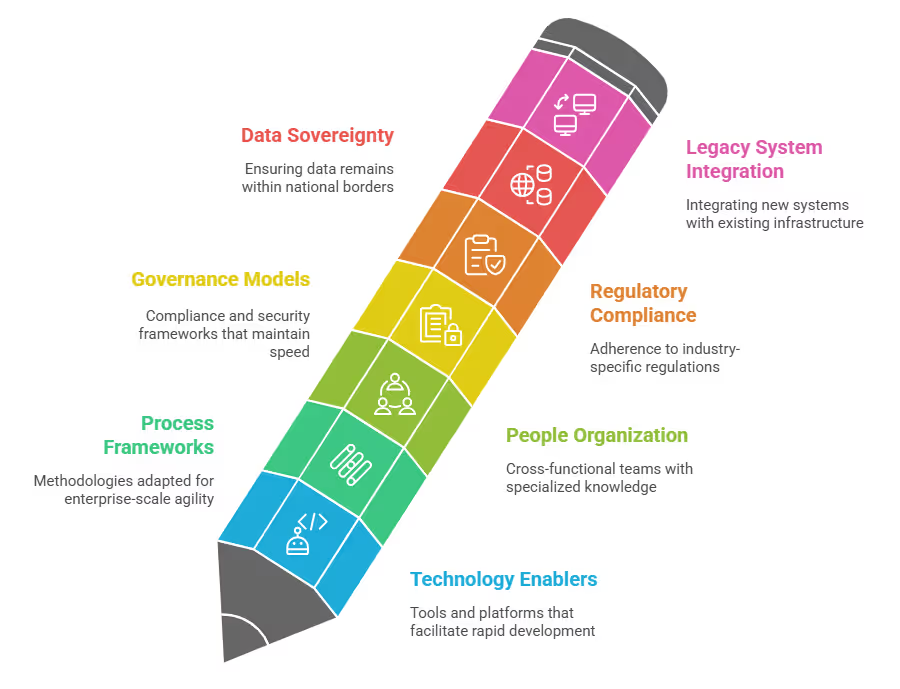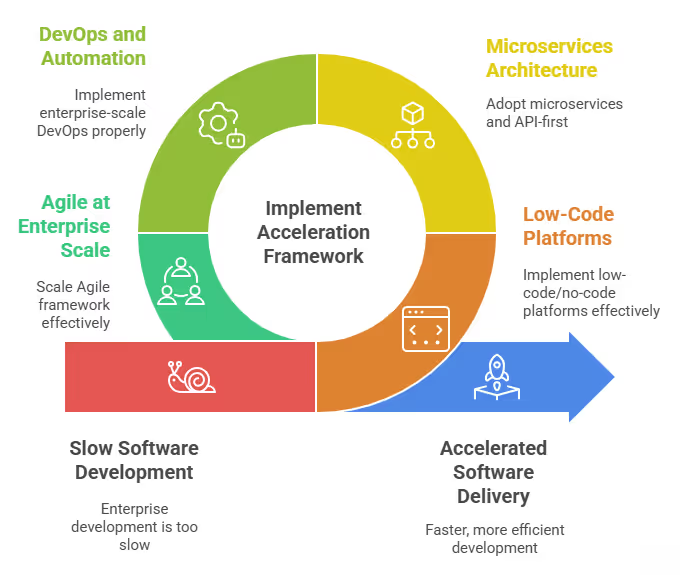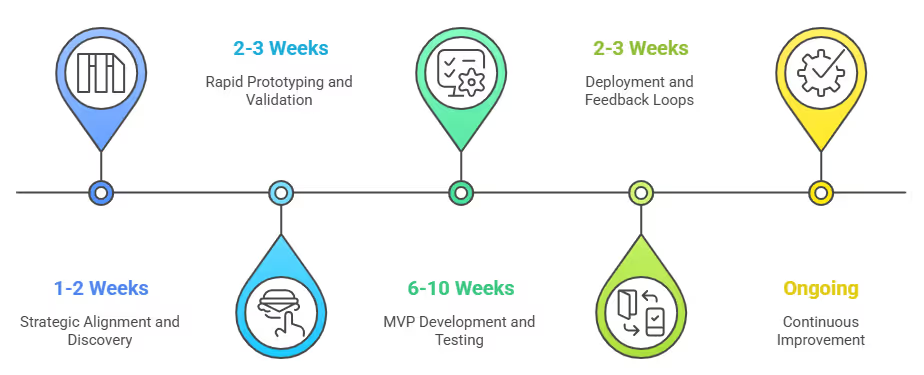Enterprise Rapid Application Development: Key Tools and Benefits

Enterprise Rapid Application Development: Strategies to Transform Your Business
According to McKinsey, organizations that prioritize speed in software development outperform their peers by 2.4x in revenue growth. After delivering over 500 enterprise applications for Fortune 1000 companies across the United States, we’ve discovered that rapid application development isn’t just a methodology, it’s a competitive necessity. In today’s American enterprise landscape, where digital transformation initiatives face a 70% failure rate, the ability to quickly develop, test, and deploy applications has become the dividing line between market leaders and followers.
As a mobile application development company with 12 years of experience serving U.S. enterprises from healthcare to finance, we’ve refined our rapid application development approach to meet the unique regulatory, security, and scalability requirements of American businesses.
This comprehensive guide examines how enterprise rapid application development has evolved in 2025, focusing on methodologies that deliver measurable business outcomes for U.S. organizations.
Enterprise rapid application development is a strategic approach that combines low-code platforms, agile methodologies, and DevOps practices to reduce application delivery time by 60-80% while maintaining enterprise-grade security, compliance, and scalability for U.S. businesses.
What is Enterprise Rapid Application Development?
Enterprise Rapid Application Development (RAD) represents the evolution of traditional RAD methodologies specifically tailored for complex organizational environments.
Unlike conventional development approaches that might take 12-18 months to deliver value, enterprise RAD accelerates software delivery cycles to weeks or even days.

The Evolution of RAD for Enterprise Environments
The RAD methodology has come a long way since its introduction by James Martin in the 1990s. What began as a response to waterfall development has transformed into a sophisticated enterprise strategy encompassing:
- Low-code/no-code development platforms
- Microservices architecture
- Continuous integration/continuous deployment (CI/CD)
- DevSecOps integration
- Enterprise-grade governance
In U.S. enterprises particularly, RAD has evolved to address industry-specific regulatory requirements like HIPAA in healthcare, SOX for financial services, and FedRAMP for government contractors, considerations that consumer-focused RAD often overlooks.
Key Components of Modern Enterprise RAD
Modern enterprise RAD stands on four pillars:
- Technology enablers: Low-code platforms, containerization, microservices
- Process frameworks: Agile methodologies adapted for enterprise scale
- People organization: Cross-functional teams with specialized enterprise knowledge
- Governance models: Compliance and security frameworks that don’t impede speed
For U.S. companies specifically, enterprise RAD typically includes additional components addressing data sovereignty, compliance with state-specific regulations (like CCPA in California), and integration with legacy systems common in established American corporations.
Why Accelerated App Development Matters for U.S. Enterprises
The stakes for U.S. enterprises are particularly high in today’s competitive landscape. According to Gartner, 87% of senior business leaders say digitalization is a priority, yet only 40% have brought digital initiatives to scale.
The ability to rapidly develop and deploy applications directly impacts:
Cost Reduction and Resource Optimization
The economics of enterprise application development in the U.S. are compelling:
- Traditional development: $250,000-$1.5M per enterprise application
- RAD approach: $50,000-$300,000 per equivalent application
This 5x cost difference comes primarily from reduced development time, fewer specialized resources, and decreased maintenance requirements. For a Fortune 500 client in Texas, we reduced annual application development costs by 62% through systematic implementation of accelerated software delivery practices.
Risk Mitigation and Compliance Management
For U.S. enterprises, particularly in regulated industries, risk isn’t just about project failure, it’s about compliance violations that can result in significant penalties. Enterprise RAD methodologies incorporate compliance requirements from the beginning, reducing the risk of:
- Data privacy violations (average cost of $9.44M per breach in the U.S.)
- Regulatory non-compliance (penalties can reach 4% of global revenue)
- Security vulnerabilities (which increase 24% for every month of development time)
How to Accelerate Software Development in Enterprise Environments
Achieving truly accelerated software development requires a systematic approach that addresses technology, process, and organizational factors.
Based on our experience with over 200 enterprise clients across the United States, we’ve developed a framework that consistently delivers results.

Implementing Low-Code/No-Code Platforms Effectively
Low-code platforms have matured significantly for enterprise use. Leading platforms like OutSystems, Mendix, and Microsoft Power Platform now offer enterprise-grade security, scalability, and integration capabilities that make them viable for mission-critical applications.
Key implementation strategies include:
- Start with well-defined use cases: Customer portals, operational dashboards, and workflow applications typically yield the fastest ROI for U.S. enterprises
- Establish governance early: Create clear guidelines for when low-code is appropriate versus traditional development
- Build a center of excellence: Dedicate resources to platform expertise, reusable components, and best practices
For a healthcare provider with 35 facilities across California, we implemented OutSystems to accelerate app development for patient engagement applications, reducing time-to-market from 8 months to 6 weeks while maintaining HIPAA compliance.
Microservices and API-First Architecture
Monolithic applications remain one of the biggest barriers to speed in enterprise environments.
Adopting microservices and API-first approaches allows for:
- Parallel development streams
- Independent deployment cycles
- Improved fault isolation
- Easier scaling of development teams
We helped a financial services company in Massachusetts decompose their monolithic loan processing system into 37 microservices. The result: deployment frequency increased from quarterly to weekly releases, and new feature delivery accelerated by 73%.
DevOps and Automation for Accelerated Software Delivery
Enterprise-scale DevOps remains one of the most powerful accelerators when properly implemented.
Key components include:
- Continuous Integration/Continuous Deployment: Automated testing and deployment pipelines reduce manual intervention
- Infrastructure as Code: Environment provisioning reduced from weeks to hours
- Automated Quality Gates: Security, performance, and compliance checks built into pipelines
A U.S. retailer with 1,200 stores nationwide achieved 95% reduction in deployment time and 82% fewer production defects after implementing our enterprise DevOps framework.
Agile at Enterprise Scale
While most U.S. enterprises have adopted some form of Agile, few have properly scaled it.
Effective enterprise Agile includes:
- Scaled Agile Framework (SAFe) or Disciplined Agile Delivery (DAD): Frameworks designed for enterprise complexity
- Product-oriented teams: Organized around business capabilities rather than technical components
- Decentralized decision-making: Empowered teams with clear guardrails
For a manufacturing client with operations in 12 U.S. states, implementing SAFe reduced time-to-market for new applications by 65% while improving business stakeholder satisfaction scores from 3.2/10 to 8.7/10.
Accelerated Product Development Process for Enterprise Mobile Applications
Mobile applications present unique challenges and opportunities for accelerated development in enterprise environments.
The process we’ve refined for U.S. enterprise clients includes:

1. Strategic Alignment and Discovery (1-2 Weeks)
- Business case definition with quantifiable outcomes
- User research specific to enterprise contexts
- Technical discovery including integration requirements
- Compliance and security requirements definition
2. Rapid Prototyping and Validation (2-3 Weeks)
- Interactive prototypes focused on critical user journeys
- Stakeholder validation workshops
- Technical proof of concepts for high-risk components
- Early security and compliance reviews
3. MVP Development and Testing (6-10 Weeks)
- Feature prioritization based on business impact
- Sprint-based delivery with weekly demonstrations
- Automated testing including security and performance
- Integration with enterprise systems and authentication
4. Deployment and Feedback Loops (2-3 Weeks)
- Phased rollout strategies (common in U.S. enterprises)
- Analytics implementation for user behavior tracking
- Feedback collection mechanisms
- Initial performance monitoring
5. Continuous Improvement (Ongoing)
- Regular enhancement releases
- Performance optimization
- Security updates and compliance auditing
- Feature expansion based on usage data
This process has enabled us to deliver enterprise mobile applications for U.S. clients in 12-18 weeks compared to the industry average of 7-9 months, without compromising on quality or compliance.
Fast Software Development: Tools and Technologies Driving Speed
The technology landscape for accelerated software development continues to evolve rapidly.
For U.S. enterprises specifically, several tools and technologies have proven particularly effective:
Low-Code Development Platforms with Enterprise Capabilities
Mobile Application Development Frameworks
Backend Technologies Enabling Speed
Backend choices significantly impact development velocity. For U.S. enterprises, we’ve seen the greatest acceleration with:
- Serverless Architectures: Using AWS Lambda or Azure Functions to eliminate infrastructure management
- Containerization: Docker and Kubernetes for consistent deployment environments
- Backend-as-a-Service: Firebase, Amplify, or Supabase for common functionality
- API Management Platforms: Apigee, MuleSoft, or Azure API Management for enterprise integration
Accelerated Product Development: Balancing Speed and Quality
One of the most persistent myths about rapid application development is that it sacrifices quality for speed. Our experience with U.S. enterprise clients demonstrates the opposite, properly implemented RAD approaches actually improve quality through:
Built-in Quality Assurance
Rather than treating QA as a separate phase, enterprise RAD integrates quality throughout the development process:
- Test-Driven Development: Requirements expressed as automated tests
- Continuous Testing: Automated regression testing on every code change
- Shift-Left Security: Security testing early in the development cycle
- Accessibility Compliance: Automated checks for ADA compliance (particularly important for U.S. companies)
For a government contractor in Virginia, this approach reduced post-release defects by 87% while simultaneously accelerating development by 4.5x.
Risk-Based Acceleration
Not all components of an enterprise application require the same level of scrutiny. A risk-based approach focuses rigorous testing and validation on:
- Components handling sensitive data
- Integration points with critical systems
- High-visibility user interfaces
- Regulatory-impacted functionality
This targeted approach accelerates development without compromising on essential quality attributes.
Speed Up Software Development: Organizational and Cultural Factors
Technology alone cannot deliver sustained acceleration. U.S. enterprises that successfully implement rapid application development address organizational and cultural factors including:
Cross-Functional Teams with Decision Authority
Traditional enterprise structures with separate business, IT, and operations teams create handoffs and delays. Successful organizations establish:
- Product-oriented teams: Business and technical resources working together daily
- Embedded compliance and security: Specialists working alongside developers
- Clear decision frameworks: Reducing escalations and approval cycles
Changing Governance Models
Enterprise governance often becomes a major bottleneck. Effective approaches include:
- Risk-based governance: More oversight for high-risk projects, streamlined for others
- Continuous compliance: Automated policy enforcement rather than manual reviews
- Parallel processes: Starting compliance and security reviews early and conducting them throughout
Incentive Alignment
Enterprise incentive structures often inadvertently reward slowness through:
- Budget models that incentivize large, long projects
- Risk frameworks that penalize failure more than delay
- Performance metrics focused on utilization rather than outcomes
Organizations that realign incentives to reward speed, innovation, and customer value realize the greatest benefits from accelerated development approaches.
Accelerated Software Development Program: Creating Sustainable Capabilities
For U.S. enterprises seeking systematic improvement in development speed, establishing a formal accelerated software development program yields the most sustainable results.
Based on our experience with Fortune 500 clients, effective programs include:
Executive Sponsorship and Clear Metrics
Successful programs have:
- C-level sponsors (typically CIO/CTO and business executives)
- Clear, quantifiable goals (e.g., “Reduce time-to-market by 50% within 12 months”)
- Regular measurement and reporting
- Direct ties to business outcomes
Capability Building in Phases
Rather than attempting enterprise-wide transformation immediately, successful organizations build capabilities in phases:
- Pilot Phase: 1-2 projects with dedicated teams and clear success criteria
- Expansion Phase: Applying lessons to 5-10 additional projects across business units
- Scaling Phase: Standardizing approaches and establishing centers of excellence
- Optimization Phase: Continuous improvement and adaptation
Investment in People and Skills
Technology adoption often receives more attention than people development, but skills are equally critical. Key investment areas include:
- Technical training on new platforms and methodologies
- Process training on agile and DevOps practices
- Leadership development for managing in rapid delivery environments
- Change management and organizational adaptation
Case Study: Accelerating Enterprise Application Development in Healthcare
A leading U.S. healthcare provider with 28 hospitals and 150+ clinics across the Midwest faced increasing pressure to modernize their patient engagement systems while maintaining strict HIPAA compliance.
Their traditional development approach resulted in:
- 14-month average time-to-market for new applications
- $1.2M average cost per application
- Difficulty retaining technical talent due to outdated practices
- Inability to respond to changing patient expectations
Our comprehensive enterprise RAD implementation included:
- Technology Transformation:
- Implemented OutSystems low-code platform for patient-facing applications
- Established microservices architecture for core healthcare services
- Created HIPAA-compliant CI/CD pipelines with automated security testing
- Process Redesign:
- Implemented SAFe across development teams
- Established product-oriented teams aligned to patient journeys
- Created streamlined governance model with automated compliance checks
- Organizational Change:
- Developed internal center of excellence for low-code development
- Trained 45 existing developers on new methodologies
- Embedded compliance and security specialists within development teams
Results after 18 months:
- Application delivery time reduced from 14 months to 10 weeks
- Development costs reduced by 68%
- 94% increase in patient satisfaction with digital services
- Compliance violations reduced to zero despite increased development velocity
The Future of Enterprise Rapid Application Development
As we look toward the future of enterprise application development in the United States, several trends will further accelerate software delivery while maintaining the quality, security, and compliance requirements of enterprise environments:
- AI-augmented development will automate routine coding tasks, potentially doubling developer productivity
- Composable architecture will enable enterprises to assemble rather than build many application components
- Democratized development will expand development capability beyond traditional IT teams
- Integrated security and compliance will shift from gatekeeping to enablement
For U.S. enterprises seeking to thrive in an increasingly digital economy, the ability to rapidly deliver high-quality software has become a core competitive requirement. Organizations that systematically implement the accelerated software development approaches outlined in this guide can expect not only faster delivery but also improved quality, reduced costs, and greater business agility.
The enterprises that will succeed aren’t simply those that adopt specific technologies or methodologies, but those that embrace speed as a fundamental organizational capability—building the technical foundations, processes, and culture needed to deliver value to customers at the pace the market demands.
Take Action Today
Ready to transform your enterprise’s application development capabilities?
Contact our team of U.S.-based enterprise mobility experts for a personalized assessment of your current state and a roadmap to accelerated delivery.
With over 500 successful enterprise implementations across 35 states, we have the expertise to help you achieve dramatic improvements in development speed without compromising on the enterprise requirements that matter most.

